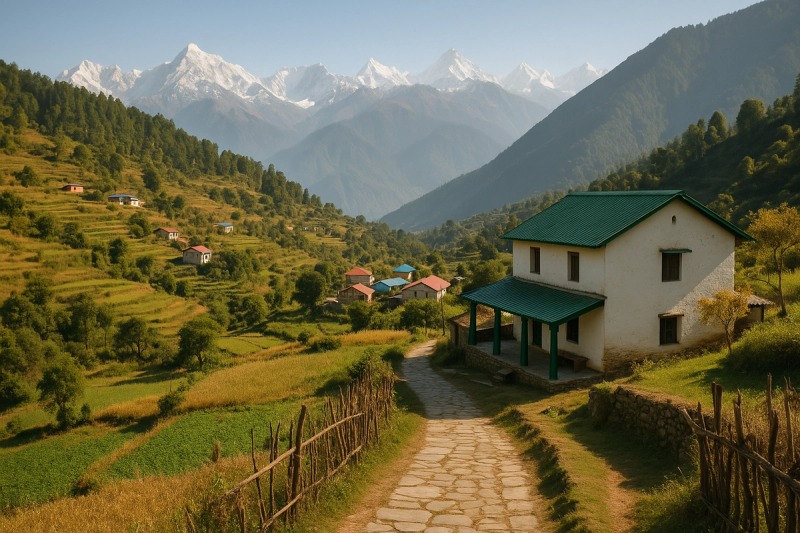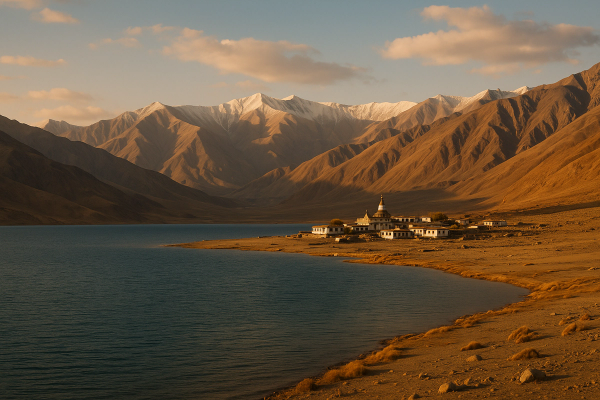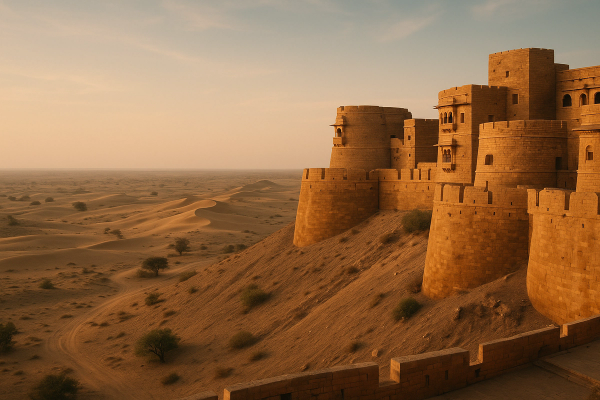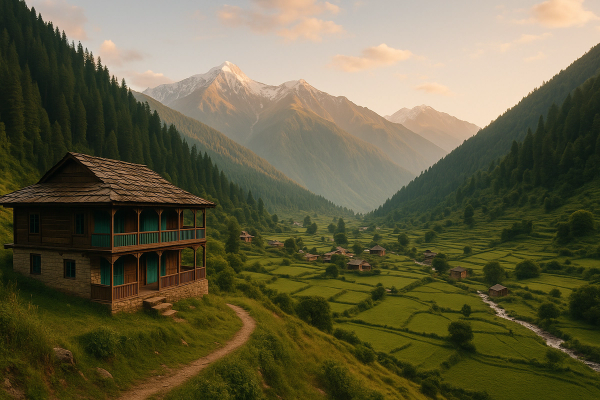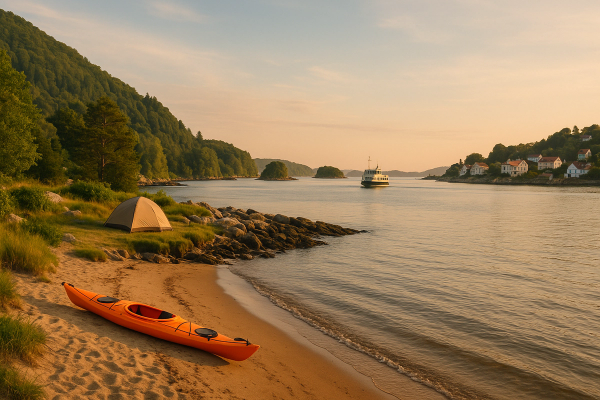Khirsu & Munsiyari Guide: Quiet Hill Villages in Uttarakhand (a very real, very personal trip)#
I finally did it. Packed my old rucksack, stuffed in too many socks, and just took off for two quiet corners of Uttarakhand that kept popping up in conversations with pahadi friends — Khirsu in Garhwal and Munsiyari in Kumaon. Not the usual Mussoorie-Nainital run. These two are slower, softer, and honestly, a little stubborn about staying old-school. I wanted mountains without the honking. Tea without the rush. And some place where, you know, the morning still smells like pine and smoke from someone’s chulha. This trip gave me all that and more, with a few surprises, a few wrong turns, and a lot of warm rotis in between.¶
Where are Khirsu and Munsiyari, and why do they feel… different?#
Khirsu sits above Pauri (roughly 15–20 km away), wrapped in tall deodars, with big-as-a-poster views of the Greater Himalaya. You get Chaukhamba on a clear day and you suddenly go quiet, like your mind just pulled the handbrake. It’s around 1700 m, so not too high, not too low — the “Goldilocks” of hill heights. Munsiyari is way deeper in the Kumaon hills, near the Nepal–Tibet trade routes of old, with the Panchachuli peaks staring right into your soul at sunrise. Elevation around 2200 m, winters hit proper, and the air has this crisp, serious vibe like the mountains are actually watching you. Both spots are calm without being boring, local without being standoffish. I felt welcome. And I didn’t feel like a walking ATM, which happens sometimes in over-touristed towns. Also worth saying — these are functioning villages first, tourist places later, so expect charm with a side of real life.¶
Getting there and getting around (without losing your mind)#
For Khirsu, the easy way is Delhi to Rishikesh by overnight bus or train to Haridwar/Rishikesh, then shared taxis or a local bus to Pauri, and from there a taxi up to Khirsu. If you’re driving, I liked the Rishikesh–Devprayag–Srinagar–Pauri route. Roads are mostly decent but monsoon throws mood swings, so don’t drive after dark if it’s raining. Nearest airport is Dehradun’s Jolly Grant, but tbh by the time you count taxi costs, the bus-train combo feels cheaper and simpler. Once in Khirsu, you won’t need a car daily. You’ll walk, and that’s the whole point. For exploring nearby temples or orchards, your homestay uncle will arrange a taxi in five minutes flat.¶
Munsiyari is a long ride but worth every bend. Most folks go via Haldwani–Almora–Bageshwar–Thal–Birthi–Munsiyari. Shared Sumos ply Almora to Munsiyari early mornings. Another route is via Pithoragarh if you’re already in the eastern belt. There’s an airport at Pithoragarh (Naini Saini), where flights have been on-and-off — as of early 2025, services keep resuming and pausing, so check latest schedules before planning around a flight. The last stretch after Birthi is mountain theatre, with the road topping out at Kalamuni before dropping into Munsiyari. In winter, fresh snow can shut Kalamuni for a day or two. BRO usually clears it quick when weather settles. If you’re self-driving, fill fuel at Thal or Pithoragarh — pumps in the upper valley can be iffy. And seriously, plan your drive so you arrive by afternoon. Hill roads + post-sunset + fatigue… not a nice cocktail.¶
Best time to visit (and what the mountains are doing each season)#
Spring to early summer is my fav — March to May — because the forests around both places go red with rhododendron blooms. Locals call it buransh and they make a sweet juice out of the flowers that I had with almost every lunch. Post-monsoon, from late September to November, the skies open up like someone wiped the glass. That’s prime time for big peak views. Winters are for snow chasers, especially in Munsiyari, where Jan–Feb can turn the whole place into a slow-motion snow globe. Khirsu gets chilly but manageable; it’s lower, so snow isn’t guaranteed every winter. Monsoon, honestly, is lush and moody and incredibly photogenic… between landslide alerts. If you do come in July–August, track Uttarakhand Police and SDRF updates on X, and don’t argue with a “road closed” sign. Mountain rules are very simple — they don’t negotiate.¶
Stays and real-world costs (no fancy fluff, just usable info)#
Khirsu has that old-school GMVN Tourist Rest House sitting right on a ridge with stupidly good views. Rooms are basic-clean, think 1500–3000 a night depending on the category and season. There are a couple of small boutique cottages that touch 3500–6000 with prettier interiors, and a growing bunch of homestays in the 1200–2500 range with hearty meals and stories. I stayed in a homestay where the host’s mother insisted I eat “one more roti beta” till I could barely breathe. Network was decent on Jio for me, Airtel worked on and off, BSNL still has the knack for popping up where nothing else does. WiFi is home-grade. Don’t come here to upload reels in real-time. Come to nap and wake up to fog and bird chatter and chai.¶
Munsiyari’s KMVN has one of the best panoramas in town, right over the Panchachuli. Rooms 1800–3500ish. Private hotels and lodges cluster near the main market and Sarmoli side, from 2000–5000. Community-run homestays in Sarmoli are a vibe — warm people, simple rooms, local food, eco-ethos that actually means something, not just marketing. I paid 1700 per night including two meals at a Sarmoli home, and felt like a cousin who never left. If you care about birding, check out the Sarmoli bird walks in late spring. Strong trend lately is experiential stays — weaving demos in Darkot, guided village walks, even tiny nature classrooms for kids. Just book early in peak season. ATMs exist in Munsiyari but cash-out happens. Carry cash from Almora or Pithoragarh. UPI works, then randomly doesn’t. Mountain tech karma is unpredictable.¶
What to do in Khirsu (the unhurried, heart-full version)#
Honestly, Khirsu is for chilling. Slow breakfasts, long walks under deodars, and quick temple hops. The Ghandiyal Devta temple is a small, sturdy, very Garhwali place that locals treat with everyday respect. Views are everywhere — even the school ground opens to the Himalaya like a cinema screen. I did a lazy loop walk through apple orchards and tiny hamlets where dogs followed me like they were showing the way. If you have a car, you can dip down to Pauri to see Kyunkaleshwar temple and the old bazaar that sells everything from rajma to raincoats. Back in Khirsu, sunsets turn orange and then purple, and silence becomes this comfortable friend you hadn’t met in ages. Not everything needs a checklist. Sometimes you just sit and sip and stare.¶
What to do in Munsiyari (beyond the postcard peaks)#
Everyone talks about the Panchachuli, and they should, because sunrise on those jagged five is a straight-up goosebump. But Munsiyari is more than the view. I hiked up to Khaliya Top, which is a moderate trek you can do as a long day if you start early or split with a meadow camp if you want to laze. In winter it’s a classic snow trek with those clean white undulations. Thamri Kund is another shorter trail near Kalamuni, through dark forests that feel very, very old. Birthi Falls on the way in is a thunder of water spray. Don’t skip Darkot village — the weaving there is a living thing, and the Shauka (also called Johar or Bhotia) community keeps the craft rooted. Nanda Devi temple in town is where people come with small prayers, and big ones. Madkot hot springs down the valley are perfect on a cold day, just go early before crowds. And Betulidhar meadows for sunset? I stood there and the light did that golden wash thing on the valley, and a dog wandered over and sat next to me like we’d planned it.¶
Treks, permits, guides — the not-boring basics you should know#
Munsiyari is the gateway for bigger stuff like Milam Glacier, Ralam Glacier, and Nanda Devi East base camp. These aren’t casual walks. Get a local guide — it’s good for safety, and it keeps money in the valley. Typical guide rates hover 1500–2500 per day depending on route and season, porters around 1000–1500, mule transport extra. For glacier treks you’ll need forest permissions, and if you’re a foreign national there can be additional permits beyond Munsiyari. Your homestay or local operators sort paperwork quickly if you plan a few days in advance. Also, leave-no-trace is not a trendy phrase here. It’s survival. Pack out what you pack in. No one is paid to clean your plastic at 3500 m. Weather flips fast, so carry proper layers, a rain shell even in “clear” season, and snacks that don’t turn sad if it drizzles.¶
Food and chai — the real reason I travel, low-key#
If I had to pick the taste of these hills, it would be aloo ke gutke with bhang ki chutney, a hot bowl of jhangora ki kheer, and a pile of mandua rotis with ghee that smell like a hug. In Garhwal side, try kafuli and chainsoo when you can find them in a homestay or dhaba that still cooks local. Munsiyari leans Kumaoni, so look for bhatt ki churkani, red rajma, and seasonal saag — sisunak, that stinging nettle one, is delicious when handled right. You’ll also find Maggi with eggs because mountains and Maggi are married now, can’t help it. Buransh juice in spring is a must. And on the way via Almora, grab bal mithai or a singori bundle, they travel well if you don’t eat them all in the cab like me and my friend did. Cafes with big menus do exist, but the real magic is eating at a family table, listening to soft conversations in Kumaoni or Garhwali while the pressure cooker hisses along.¶
Practical tips: safety, money, network, little stuff that saves the day#
Register your trip on the Tourist Care Uttarakhand app or website — it’s free and has SOS features that are actually useful if something goes sideways. During monsoon, follow Uttarakhand Police and SDRF updates on X for landslide advisories. Don’t be the person who argues with a jawan at a blockade. Cash is king beyond the district HQs. Carry enough from Almora or Pithoragarh for Munsiyari, and from Pauri or Srinagar for Khirsu. UPI is fine till it isn’t. ATMs can go dry on holidays and paydays. Network is patchy in pockets, Jio did best for me but changed its mind every few bends. Medical? There’s a PHC in Munsiyari and clinics in Pauri, but for anything serious you’ll head to Pithoragarh or Srinagar. If you’re renting a bike or driving a small hatch, keep tyre pressure slightly up, carry a basic puncture kit, and don’t push water crossings after heavy rain. Also, drink more water than you think you need. Mild altitude plus dehydration equals weird headaches that ruin evenings.¶
A chill 6-day loop itinerary that actually works#
Day 1: Overnight to Rishikesh or Kathgodam depending on your plan. I did Rishikesh, connected to Pauri by noon, and reached Khirsu for sunset. Settle in, walk the ridge, early dinner, sleep like a log. Day 2: Khirsu slow day — Ghandiyal Devta darshan, orchard walk, a book and tea marathon. Optional quick run to Pauri’s bazaar if you want snacks and a sweater that says Himalaya Adventure with a wolf on it. Day 3: Long transit day to Munsiyari — start before dawn, stop at Kausani for chai if you’re routing via Almora, lunch around Bageshwar or Thal, stretch at Birthi Falls. Reach Munsiyari before dark. Day 4: Khaliya Top day hike. If there’s snow, carry microspikes or at least good grip shoes, start early, and back down before evening chill. Day 5: Slow culture day — Darkot weaving, Sarmoli stroll, Nanda Devi temple, and sunset at Betulidhar. If it’s cold, soak at Madkot hot springs before lunch and nap like a king. Day 6: Buffer day for Thamri Kund or just sit and sketch the Panchachuli. Return next morning or overnight to Haldwani/Almora and onwards. This loop balances one heavy travel day with easy days. If you cut it to 5 days, skip the buffer and stick to one big hike only.¶
Traveling to Khirsu and Munsiyari felt like turning down the volume on life till I could hear my own thoughts again — and they sounded kinder up there.
Local culture and small courtesies that go a long way#
In Khirsu, most families are Garhwali, soft-spoken and practical. In Munsiyari and the Johar valley, many are from the Shauka community with deep trading history towards Tibet. A few small courtesies help — don’t photograph people without asking, don’t wander into fields at harvest, and if you’re hiking through a village path, a simple “Namaste” or “Jai Badri Vishal” melts all awkwardness. Buy something local even if it’s small. A handwoven muffler from Darkot carries a story into your winters back home. Tip your guide and your homestay help. If a dog adopts you on a trail, it’s usually a mountain guardian dog just doing rounds. A biscuit is fine, but please no plastic wrappers left behind. Leave woodpiles alone, they’re winter savings. And yes, don’t blast music on trails. The mountain already has a soundtrack — wind, bells, and your own breath.¶
Ballpark budget (per person), so you don’t need a spreadsheet#
Delhi to hills bus or train: 800–1800 one way depending sleeper or chair. Taxis up from Rishikesh/Pauri: 200–400 for shared, 1500–2500 for reserved short rides. Long private taxi to Munsiyari is pricey — 8k–12k depending on season and negotiation. Stays: Homestays 1200–2500 in Khirsu, 1500–3000 in Munsiyari with meals sometimes included. KMVN/GMVN 1800–3500 standard rooms. Food: 400–800 per day if you eat local, more if you chase cappuccinos. Guides: 1500–2500 per day. Misc like entry fees, tea stops, emergency snacks, and the scarf you didn’t need but bought anyway — add 1000–2000. A 6-day, no-frills but comfortable trip lands around 15–25k per person if you share rides smartly. You can do it cheaper, and you can blow it up easily. Hills are like that.¶
A few lesser-known moments I loved#
- A silent morning in Khirsu where the school kids walked to class in sweaters two sizes too big, and the bell rang like a tiny temple. - A chai stall between Thal and Birthi where the aunty put extra ginger because I coughed once, and then gave me an entire lecture on road manners. - A weaving demo in Darkot where the loom’s rhythm felt like rain on a tin roof. - A short detour to Sarmoli’s forest edge at dawn, blue whistling thrush doing SRK levels of drama near the stream. - That awkward but adorable pause when I tried to speak broken Kumaoni and ended up inventing a new language.¶
If you’re deciding between the two… or wondering if you should do both#
Do both if you have 6–7 days. They’re different moods in the same mountains. Khirsu is a retreat with a view, comfy and green, perfect if you want to work a little, read a lot, and reset. Munsiyari is for people who want to feel small in the best way, and still want chai at 7 am with a front-row seat to the Himalaya theatre. If time is tight and you must pick one, choose Khirsu for a gentle break and family-friendly vibes, choose Munsiyari if you’re okay with a long travel day and want to hike, learn, and return slightly changed.¶
What’s new-ish and useful to know right now#
The big trend up here is community-led tourism. Sarmoli’s homestays, guided nature walks, bird festivals — they set a template a lot of villages are adapting. In both regions, waste segregation is becoming standard in good stays. People are asking you to carry a bottle, refill, and skip single-use stuff. Roads get repaired faster after weather events than they used to, but still, monsoon is monsoon, and winter snow is winter snow. Keep a buffer day if you’re catching a train or flight onward. Flights to Pithoragarh keep playing musical chairs, so don’t hinge a wedding or a visa appointment on them. And one more thing — book stays directly with the property when possible. Better rates, more accurate info, and someone will actually wait for you if you’re late.¶
Final thoughts — would I go back?#
In a heartbeat. Khirsu felt like someone handed me a warm sweater and told me to sit by the window for as long as I liked. Munsiyari felt like standing in a big quiet cathedral where the wind does the singing. I came back with a lighter head and an even heavier craving for pahadi dal. If you’re planning, go slow, be kind, spend local, and keep a little room in the plan for weather and wonder. Also, if you want more Indian travel stories and practical guides like this, I keep bookmarking stuff from AllBlogs.in — worth a look when you’re figuring out where to drift next.¶

